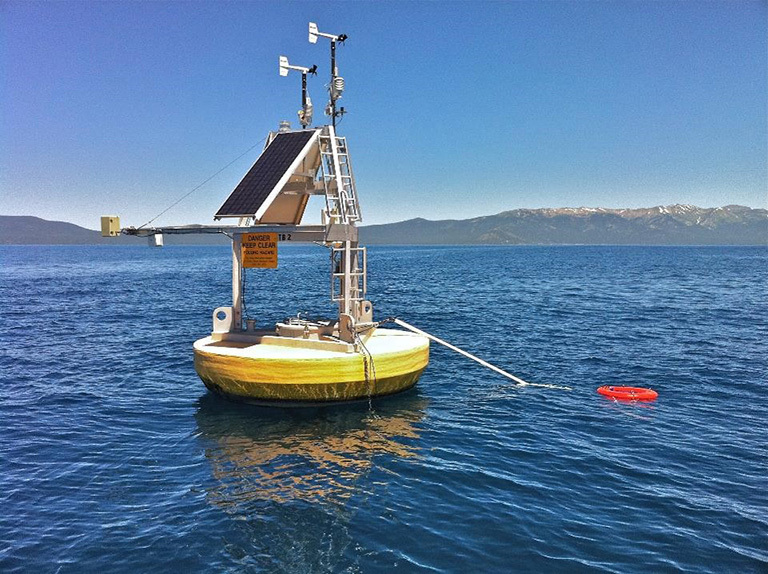News | December 15, 2015
Study: Climate change rapidly warming world's lakes

A combination of satellite data and ground measurements, such as from instrumented buoys like this one in Lake Tahoe on the California/Nevada border, were used to provide a comprehensive view of changing lake temperatures worldwide. The buoy measures the water temperature from above and below. Credit: Limnotech.
Climate change is rapidly warming lakes around the world, threatening freshwater supplies and ecosystems, according to a new NASA and National Science Foundation-funded study of more than half of the world's freshwater supply.
Using more than 25 years of satellite temperature data and ground measurements of 235 lakes on six continents, this study — the largest of its kind — found lakes are warming an average of 0.61 degrees Fahrenheit (0.34 degrees Celsius) each decade. The scientists say this is greater than the warming rate of either the ocean or the atmosphere, and it can have profound effects.
The research, published in Geophysical Research Letters, was announced Wednesday at the American Geophysical Union meeting in San Francisco.
"Society depends on surface water for the vast majority of human uses," said co-author Stephanie Hampton, director of Washington State University's Center for Environmental Research, Education and Outreach in Pullman. "Not just for drinking water, but manufacturing, for energy production, for irrigation of our crops. Protein from freshwater fish is especially important in the developing world."
Water temperature influences a host of its other properties critical to the health and viability of ecosystems. When temperatures swing quickly and widely from the norm, life forms in a lake can change dramatically and even disappear.
"These results suggest that large changes in our lakes are not only unavoidable, but are probably already happening," said lead author Catherine O'Reilly, associate professor of geology at Illinois State University, Normal. Earlier research by O'Reilly has seen declining productivity in lakes with rising temperatures.
Study co-author Simon Hook, science division manager at NASA's Jet Propulsion Laboratory in Pasadena, California, said satellite measurements provide a broad view of lake temperatures over the entire globe. But they only measure surface temperature, while ground measurements can detect temperature changes throughout a lake. Also, while satellite measurements go back 30 years, some lake measurements go back more than a century.
"Combining the ground and satellite measurements provides the most comprehensive view of how lake temperatures are changing around the world," he said.
Previous work by Hook, using satellite data, indicated many lake temperatures were warming faster than air temperature and that the greatest warming was observed at high latitudes, as seen in other climate warming studies. This new research confirmed those observations, with average warming rates of 1.3 degrees Fahrenheit (0.72 degrees Celsius) per decade at high latitudes.
Warm-water tropical lakes may be seeing less dramatic temperature increases, but increased warming of these lakes still can have significant negative impacts on fish. That can be particularly important in the African Great Lakes, where fish are a major source of food.
"We want to be careful that we don't dismiss some of these lower rates of change," said Hampton. "In warmer lakes, those temperature changes can be really important. They can be just as important as a higher rate of change in a cooler lake."
In general, the researchers write, "The pervasive and rapid warming observed here signals the urgent need to incorporate climate impacts into vulnerability assessments and adaptation efforts for lakes."
For more information about NASA's Earth science activities, visit:
Media contacts
Alan Buis
Jet Propulsion Laboratory, Pasadena, Calif.
818-354-0474
Alan.Buis@jpl.nasa.gov
Steve Cole
NASA Headquarters, Washington
202-358-0918
stephen.e.cole@nasa.gov
Eric Sorensen
Washington State University, Pullman
509-335-4846
eric.sorensen@wsu.edu





